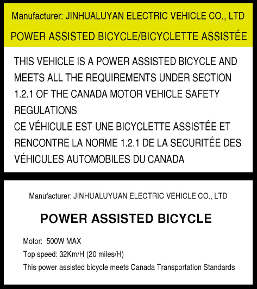 Are you going green? Is an e-bike something that you are considering the purchase of to help you get around? Riding purpose built electric bikes or adding an electric motor to a conventional bicycle to help out with the chore of pedalling uphill or giving a boost to your efforts on level ground sure sounds good!
Are you going green? Is an e-bike something that you are considering the purchase of to help you get around? Riding purpose built electric bikes or adding an electric motor to a conventional bicycle to help out with the chore of pedalling uphill or giving a boost to your efforts on level ground sure sounds good!
What Are Electric Bikes?
A motor assisted cycle (aka: electric bike or e-bike) is described in B.C.'s Motor Assisted Cycle Regulation. Requirements for legal use on our roads include:
- It must have an electric motor with a power of 500 watts or less
- It must not travel faster than 32 km/h on level ground when propelled by the motor alone
- It must be switched on or off by the rider or controlled by a switch that will not let the motor start until a speed of 3 km/h has been attained by pedalling
- The motor must disengage when the rider quits pedalling, applies the brake or releases the accelerator
- It must have pedals to allow the rider to move it by muscular power
- It must not have more than 3 wheels and those wheels must be at least 350 mm in diameter
Do Electric Bikes Need Licences & Insurance?
Anyone 16 years of age or older may operate a motor assisted cycle in the same manner as a bicycle. No driver's license, vehicle license or insurance is required, but a bicycle helmet is mandatory.
If the motor assisted cycle does not meet the requirements of the regulation such as a larger motor, modifications made to remove the pedals or change the way in which the motor operates it becomes a motorcycle in the eyes of the Motor Vehicle Act. This means the rider needs a motorcycle helmet, driver's license, vehicle license and insurance.
Shopping for Electric Bikes
As of February 2021, Transport Canada has decided that it will no longer regulate power assisted bicycles (PAB) whose top speed is 32 km/h or less. This is being left to the provinces and could mean that the PAB label will no longer be affixed by manufacturers.

If the label is present, you can be reasonably assured that you are buying an electric bicycle. If not, it's buyer beware. Consider having the vendor certify that the e-bike they are selling you meets B.C. rules on the bill of sale.
Do It Yourself Conversions
Yes, you can convert conventional bikes into electric bikes if you are handy with tools. The pitfall here is that some kits contain motors of more than 500 watts total power. Using a conversion kit with a motor power of more than 500 but less than 1,500 watts would mean that you are building a limited speed motorcycle instead of an electric bike.
ICBC
A comparison of motor assisted cycles and limited speed motorcycles.
Share This Article
Being it has a motor, is it possible to garner an impaired by alcohol charge? Asking for a friend, serious.....
- Log in to post comments
I asked Kyla Lee of Acumen Law for assistance in answering this question.
The Criminal Code defines a motor vehicle as:
motor vehicle means a vehicle that is drawn, propelled or driven by any means other than muscular power, but does not include railway equipment;
Her opinion is that you cannot be charged under the Criminal Code for operating an e-bike while impaired by alcohol or a drug.
However, you could be subject to an Immediate Roadside Prohibition due to the operation of section 183 MVA as a cyclist has the same rights and duties as a driver of a motor vehicle.
- Log in to post comments
I think that all electric bicycles and such should have insurance and a licence plate. They could do a person lots of damage.
It is the same with regular bicycles. They should have insurance and a licence plate as well.
- Log in to post comments
- Log in to post comments
I start by saying I ride an ebike & have a white flashing light on the front & red flashing on the rear.
The only thing about safety I see missing is lights on an ebike on the article from ICBC, nothing about lights on the ebike. A lot of mention about speed & size of motor that in reality says the ebike is faster.
I'm not talking about direction signals, though hand signals should be obvious, lights on the front & back of the bike. ICBC is missing this safety feature. Most bikes with or without power are mingling with traffic at any time of the day & any weather. I used to be into boating.
Government regulations Lights are required in all types of weather. No need to specify the requirements that's another topic. There's no difference. Both types of modes result in a accident if you can't been seen on the water or on land. Your not getting the right of way.
As of late a cross Canada numerous accidents with bikes, that according to to the article the bike didn't have lights.
Ride safe, your only dead right once, someone is waiting for you to come home.
- Log in to post comments
- Log in to post comments

Impaired Driving